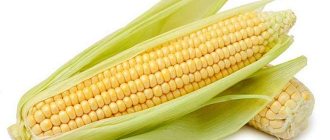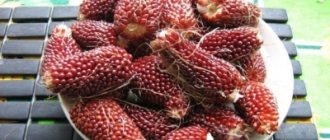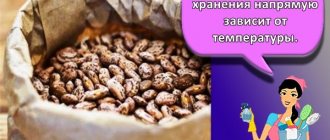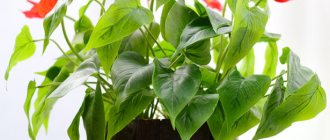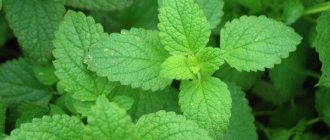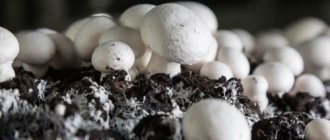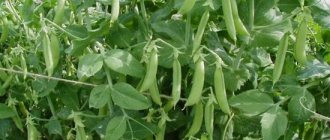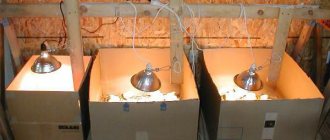Do you like popcorn? I love it very much, and this is one of the most compelling reasons to go to the cinema. Previously, I always bought only the finished product, so imagine my surprise when I found out that it can be easily made at home from a special variety of corn called “Vulcan”.
This corn can be grown in your garden if you live in a private house, bought in a supermarket (it turns out that it is sold in bags in the form of hulled seeds) or from grandmothers at the market on the cob (the latter is preferable).
I will tell you further how to get an airy delicacy from small grains, but for now I will share my impressions of the finished dessert.
It happens that you tried a dish in a cafe or restaurant, and liked it so much that you wanted to cook it at home. In the end it turned out very tasty, but a little different from the restaurant. So, in our case, the opposite happens - homemade popcorn turns out much tastier.
After all, at home we use only high-quality oil and corn grown in the garden without pesticides and other harmful substances. In addition, you can eat popcorn immediately after cooking, which means it will be fresh and still hot.
Your rating: (
2 ratings, average: 5.00 out of 5)
Cooking time: 20 minutes
Quantity: 1 serving
The history of popcorn
Tasty and healthy popcorn
The birthplace of popcorn, like corn itself, is the American continent. It is not known for certain when this dish first appeared. There is documented evidence that excavations in Mexico have uncovered “exploded” corn kernels that are over 4,000 years old. This means that already at that time popcorn was on the Indian menu.
It seems that Americans have always eaten popcorn, so it is not surprising that in our time Americans are leaders in this market. Popcorn is several thousand years old, but it was given a second life by an enterprising merchant from Chicago, Charles Critors, in the 1880s, who invented an automatic mobile popper - a device for preparing a tasty treat. New and old products began to be sold on every corner. Low cost and magical taste made it mega-popular.
By the way, ready-made popcorn comes in different types: mushroom and butterfly. The next time you eat, pay attention to who your popcorn turned into from the explosion.
The third wave of popularity hit popcorn with the advent of cinema. During the Great Depression, cheap food helped fill movie theaters. Nowadays, not a single cinema can do without a stand selling corn sweets. It's hard to say whether it's good or bad, but nowadays popcorn and movies are almost synonymous.
They say: "Popcorn saved Hollywood"
Popcorn in a special machine
The easiest and fastest way to prepare your favorite treat is a popcorn maker. But at the same time, this option is more expensive, and it is rarely possible to purchase the unit itself in ordinary household appliance stores. You can order it mainly in specialized online stores. In addition, it will be possible to purchase raw materials and additives for making popcorn.
Such devices are distinguished by a variety of sizes, functions, appearance, and accordingly have different performance and cost. Therefore, when choosing a device, you should pay special attention to all these parameters.
To make your favorite delicacy using such a machine, you just need to follow the instructions: pour in a little oil and pour out the required amount of grains. Additionally, flavoring and non-stick additives are added. The boiler is preheated to a high temperature, reaching approximately 300 degrees, under the influence of which the grains burst. In a word, everything is exactly the same as in a frying pan or in the microwave, only more automated.
But do not forget that any equipment requires careful care. Therefore, the device must be washed after each cooking process, and each time cooked with new oil. Careful operation will help avoid breakdowns and allow you to regularly delight yourself and your loved ones with the freshest, airy delicacy.
Is it possible to make popcorn from regular corn?
You probably won't be able to make high-quality popcorn from regular corn. The composition of such seeds is denser, they contain more starch and less fat. The shell is thicker, but fragile, cannot withstand pressure and bursts ahead of time, preventing the grain from fully opening. Due to the density there is less air and necessary moisture inside, there is a chance that the grains will not open at all.
On a note ! There are special devices that create a pressure of 10-12 atmospheres; they are able to transform ordinary corn. They are called “guns” for their characteristic sound.
It is more rational to use special varieties for growing or buy ready-made bags of corn seeds for popcorn in supermarkets.
What it is?
Today everyone knows what popcorn or puffed corn is.
The name comes from the English words corn - “corn”, pop - “to burst with a bang”. The honor of discovering this dish belongs to the Indians, who were the first to discover the fact that a grain of maize, when thrown into a fire, explodes, turning into delicious, airy white flowers. IMPORTANT! Corn explodes due to the presence of a drop of starch and water in it. When heated, this water boils, and the hot steam ruptures the shell, causing the grain to increase in volume.
There are many different types of popcorn:
- Sweet.
- Salty.
- With butter.
- With cheese.
- Color.
- Caramelized.
How to dry popcorn seeds
The quality of any dish is influenced primarily by the raw materials. It is important to harvest corn, specifically for popcorn, at a certain stage. If this happens at the stage of milky ripeness, the grains will not burst in the pan. It is very important that the grains are fully ripe, it is best if they are dry on the cob. The characteristic appearance of the finished grains is a glassy shell.
Harvest from the beds immediately before storing. The top layer of leaves is left on the cobs, and in this form they are dried for about a month in a dry, cool place. Then they put it in bags made of natural material. The cobs are stored without loss of properties for several years in a cool, dry room, so they can be prepared for future use. An ideal place for storage could be an insulated balcony or cellar.
Corn harvest
Be careful, over-drying corn is just as harmful as under-drying it. Over-dried grains do not contain the amount of moisture needed for an explosion. Observe the conditions for storing the crop and you will be happy. Properly prepared corn on the cob will have 95% of its kernels popped in the pan.
Popcorn in a frying pan
To prepare popcorn using this method, you only need two ingredients and a minimum amount of time.
You will need:
- Large frying pan with a thick bottom and a lid (can be replaced with a saucepan);
- Corn grains – 100 g;
- Refined corn or sunflower vegetable oil – 30 ml.
The cooking scheme is very simple:
- Pour oil into a frying pan and heat thoroughly, reduce the flame level to minimum. You don’t have to use butter at all, but the cookware should be non-stick or Teflon coated;
- Quickly place the corn evenly in one layer on the hot oil. This is necessary so that all the grains open and fry;
- Close the lid tightly, add gas and wait. After a while, popping sounds will begin to be heard from the bursting grains. They can be very strong, so you may have to hold the lid to prevent our popcorn from shooting out and spilling onto the stove;
- When the frequency of the pops decreases, you need to gently shake the frying pan without opening the lid;
- After the mixing process, remove the corn from the flame and leave to cool for 10 minutes under the lid. During this time, the remaining grains should open in hot oil. After this time, open the lid slightly. The popcorn in the pan should be ready. The product must be consumed completely cooled.
If you like salted popcorn, immediately after removing the lid, sprinkle the corn with finely granulated salt, but you can also use regular or iodized salt. A sweet version can be obtained by sprinkling the hot treat with powdered sugar, which can also be additionally flavored with cinnamon or vanilla.
Flavoring additives
There are a great many different additives to improve the taste and aroma of popcorn. Experimenting will help you find your favorite recipe. Here you will find the most popular:
- Caramel - mix 30 grams of butter, a glass of granulated sugar and a few tablespoons of water. Bring over heat until golden brown, stirring continuously. Pour the delicious liquid onto the finished popcorn and mix or shake everything in the bag.
- A hearty recipe with cheese - hard cheese is grated on a fine grater directly onto hot popcorn. The cheese will melt and it will almost be a one-dish meal. Once cooled, it is also tasty and appetizing.
- With chocolate - melt the bar and pour it over hot popcorn or add one tablespoon of cocoa to caramel.
- For those who like spicy foods , take two liters of water: 50 ml of corn syrup, 100 grams of sugar, a spoonful of butter, salt, chili pepper, a pinch of vanilla. Boil the syrup until thick (15-20 minutes) and pour it over freshly cooked popcorn.
- Just sprinkle with dry seasonings : powdered sugar, cinnamon, vanilla, paprika, regular salt, lemon zest, orange zest. Bon appetit
Colored popcorn using additives
Nuances of cultivation and storage
Growing this plant is not particularly difficult. Popcorn corn and regular corn are very similar in planting and care methods. Let's look at some of the nuances.
The roots develop more slowly than those of cereal corn; the plant also does not like dry soil, requires frequent watering and may grow poorly if not weeded.
Corn for popcorn is heat-loving, so it is better to plant it in early May. 1-2 grains are placed in the dug hole. According to the recommendation, it is better to plant where nightshades previously grew: potatoes, tomatoes, etc. Since pollination with other crops can occur, plant separately from other species.
Remember the rules, the implementation of which will lead to healthy cobs and a large harvest:
- Harrow the soil before planting.
- Do inter-row cultivation about three times during the entire growing period.
- Water the corn once a week, this is the minimum.
- Do not forget to fertilize the soil in the root system with organic matter or minerals.
If you pick corn for popcorn when it is not ripe, eat it like regular sugar corn. But you won't be able to make popcorn from it.
It is better to harvest corn at the very last stage, when the mature cob begins to dry out and becomes covered with a shiny crust. It is worth preparing such seeds for further planting. It is best to store directly on the stems. To do this, we wait until the plant begins to dry completely along with the cobs; this is somewhere around the end of summer and the beginning of autumn. You should not collect corn early and dry it at home, it will explode badly.
Dry cobs are broken off and dried for about a month in a cool and dry place. Place them in cloth bags or paper bags. Good for attic or closet storage. If there is a possibility that the cobs will dry out too much, send the crop to a more humid place for several weeks. This is a cellar or balcony.
What is good about pumpkin seed flour and how to use it for health and beauty.
Is it possible to eat raw zucchini: benefits and harm to the body.
Top 15 most delicious canned tomato recipes.
Processing and preparing grains for popcorn
Special processing of popcorn grains is not needed. Store and harvest correctly. The only recommendation is to place the grains in the freezer for 20 minutes. Due to the sharp temperature change, they will explode better.
Cooking instructions
First, make sure the corn kernels are dry. If they are even slightly damp, dry the raw materials. To do this, spread the grains on clean paper and leave them in a dry, ventilated place.
Heat 1 tbsp in a frying pan. a spoonful of butter. When it starts to crackle a little, add a third of the corn and reduce the heat to medium.
Popcorn should be cooked in small batches so that the kernels are evenly heated and popped.
Cover the pan with a lid. Soon the seeds will begin to “shoot” strongly (I advise you to use a glass lid, it will be convenient to monitor the process, and it will be an interesting sight).
When the process comes to an end, remove the pan from the heat. Pour the popped corn into a dry container, pour the vegetable fat back into the frying pan and repeat the procedure with a new portion.
When all the grains become airy, mix them with powdered sugar.
By the way, making popcorn at home allows you to experiment from the heart and add to it only sugar, but also salt, various spices and herbs.
Tips and tricks
There are some tips that will help in the future:
- Dry beans that have not burst are best stored in a closed container in the freezer.
- Some grains are overdried and therefore do not burst. Soak them overnight in cold water. Then dry thoroughly.
- To prevent the popcorn from getting soggy, remove the lid as soon as it's ready to prevent condensation from forming in the bowl and water droplets falling onto the kernels.
- It is better to mix popcorn with seasoning by first mixing the kernels with butter. It would be better to place salt or sugar on a moistened surface.
Now you know everything you need to cook a great dish! Use our tips and recommendations to enjoy amazing taste not only in cinemas, but also at home.
Today, in market conditions, many commodity producers are looking for opportunities to effectively apply their potential. Considering that the food industry suffered less during the crisis, the need for high-quality raw materials justifiably arises. And one of these raw materials is popping corn.
It is clear that popcorn is not a first-tier crop such as sunflower, wheat and grain corn. However, as the experience of recent years shows, this culture has its own specifics and potential. Let's remember how fashionable the widespread production of puffed corn (popcorn) was 7-10 years ago. No less popular in a number of regions are mamalyga and banosh; corn sticks and all kinds of breakfast cereals. These are all applications for popping corn. In addition to this, we can cite information that Turkish companies (obviously knowing a lot about marketing) have shown and are showing interest in varieties and hybrids of Ukrainian popping corn. It is also obvious that such corn, when applied to processing, means new products and new markets. Today, in a market economy, the emphasis has shifted from production orientation to high productivity in order to obtain a high economic effect. Naturally, production first selects successful crops. At the same time, the potential of the food industry is simply enormous.
Another example - manufacturers of corn sticks in the Kharkov region once tried to introduce popping corn into the recipe - the effect did not take long - at a fair in Kharkov, during the day of trading they sold more products than their competitors. A tasting of all possible raw materials for preparing hominy at that time highlighted popping corn as the undisputed leader. In any case, the choice remains with producers and consumers.
So what are the features of popping corn?
In popping corn, based on the structure of the grain, two types are distinguished: rice (with a beak-shaped top of the grain) and pearl barley (with a rounded top of the grain). In appearance, pearled corn is very similar to small-grained forms of flint corn. Among the available varieties, the most common are yellow- and white-colored. The name of this food subspecies of corn is associated with the inherent unique ability to “explode” at normal atmospheric pressure due to the specific structure of the endosperm, which is almost entirely represented by the glassy fraction and only near the embryo there is a small area of mealy endosperm. Due to this structure, when heated under the pressure of water vapor, the pericarp and seed coat break through, and the endosperm turns outward in the form of a loose mass and the grain increases significantly in volume (the best varieties and hybrids - 30 times or more). The resulting products, known as “puffed corn” or “popcorn,” have high nutritional value and are very popular among the population.
At the same time, to date, crops of popping corn in Ukraine have been carried out in limited quantities. This is primarily due to the lack of reliably ripening productive varieties and hybrids in the zone, the high demands of the crop on agro-climatic growing conditions and the insufficient development of the basic elements of the technology for growing popping corn.
To obtain a full-fledged commercial product, complete ripening of the grain is required, otherwise the degree of its explosion and the coefficient of increase in grain volume are sharply reduced.
Of the varieties that have already won over their consumers, the most suitable are the pearl barley corn variety “Dneprovsky 298” bred by the Corn Institute, as well as the rice corn varieties “Oerlikon” and pearl barley “Irida” from the Institute of Plant Growing. V.Ya. Yuryeva UAAN. According to the results of production tests, their yield reaches 35–40 c/ha, which ensures the profitability of growing popping corn. There are also new developments in which production is showing interest.
Obtaining high yields of popping corn is very dependent on the correct choice of predecessor and soil fertility. The best predecessors are winter crops, legumes and vegetables. Spatial isolation of commercial crops of popping corn from conventional crops is not necessary, since cross-pollination with odontoid or flint corn practically does not reduce the technological properties of the grain.
Soil preparation should be carried out immediately after harvesting the predecessor and as early as possible. Good results are ensured by semi-steam treatment, including stubble peeling with LDG-10, autumn plowing with a layer rotation of 25–30 cm and autumn cultivation across the plowed area. For the main plowing, 30–35 t/ha of organic matter, 2–2.5 t/ha of phosphorus and 1–1.5 t/ha of potassium fertilizers are applied.
Spring pre-sowing treatment begins with harrowing in 1-2 tracks across the plowing area with tooth harrows on a C-11 hitch. After harrowing, three successive cultivations are carried out - the first at 14-16 cm, after 10-12 days - the second at 10-12 cm and immediately before sowing - the third at the seeding depth.
Sowing of popping corn in the Eastern forest-steppe zone of Ukraine is usually carried out in the third ten days of April - the first ten days of May when the soil temperature reaches +12° C at the seeding depth. Sowing is carried out with calibrated and treated seeds to a depth of 5–7 cm in a dotted manner with row spacing of 70 cm with ensuring standing density for harvesting of 50–55 thousand plants/ha. The weight norm is 7–9 kg/ha. To obtain uniform and full-fledged shoots, 1–1.5 c/ha of granulated superphosphate or 0.5–1 c/ha of complex fertilizers are added to the rows and the crops are rolled with ring rollers.
As effective pre-emergence herbicides for weed control, we can recommend “Harnes” at a dose of 2.0 l/ha, as well as “Primextra” or “Rotaprim” at a dose of 5–6 l/ha, depending on the type of soil and the spectrum of weeds. Herbicides can be applied to the soil both before sowing and simultaneously with sowing to a depth of 3–5 cm, which eliminates loss of soil moisture.
Subsequently, 2–3 inter-row cultivations are carried out. To prevent dusting, the first cultivation is carried out at a depth of 6–8 cm at a reduced speed, and weeding harrows are hung in the rows to loosen the soil. The second cultivation is carried out at 8–10 cm, the third at 10–12 cm. The protective zone should not exceed 10 cm. Good results are ensured by fertilizing in the phase of 5–6 leaves with 1–1.5 c/ha of ammonium nitrate, 1–1, 5 c/ha of superphosphate and 0.5–1 c/ha of potassium fertilizers.
The optimal average monthly temperature for the growth and development of popping corn plants is +20-24°C, however, the climatic conditions of the growing season must be accompanied by a sufficient level of moisture supply
Popping corn is very responsive to irrigation. Optimally, 2 irrigations are carried out until the full moisture capacity of the arable horizon is achieved. The first watering is carried out 10–12 days before the panicle is swept, and the second - at the beginning of grain filling. Irrigation of the hole is 600–800 m/ha, depending on the moisture and physical condition of the soil. It should be taken into account that with irrigation the growing season increases, but the increase in yield is 25–30%.
An important condition for high grain quality is the correct choice of harvesting time. Typically, harvesting is carried out in full ripeness at a humidity of 15–16%. Harvesting at higher humidity is also possible, but subject to immediate thermal drying with forced ventilation in seed mode.
For blasting, the optimal humidity is 13.5–14%, the heating temperature of the fryer is +200–210 °C. The oil used in the preparation of “puffed corn” must be refined and the use of animal fats when exploding is unacceptable. If all the specified parameters are observed, the completeness of grain explosion of modern varieties and hybrids is 94–97%, the explosion time does not exceed 3–4 minutes, and the coefficient of increase in grain volume is 22–26.
Repeated tastings and technological assessment of food products obtained from Kharkov varieties and hybrids of popping corn have confirmed their high quality and economic efficiency. Manufacturers of corn sticks have already been able to verify this. Rice popcorn groats aroused great practical interest among processors, and hominy from the Oerlikon variety took first place in the tasting. For the development of a new generation of varieties and hybrids, the Institute of Plant Growing was awarded the status of “Producer of the best domestic goods.”
S. M. Tymchuk, Engineering Academy of Ukraine. V. M. Tymchuk, Institute of Plant Growing named after V.Ya.Yuryev NAAS
